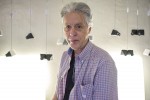Viewfinders – miniature binocular-like objects – hang side by side from long strings along one wall of the Kerckhoff Art Gallery. Small and understated, the viewfinders appear to be ordinary, until one looks inside and a whole other three-dimensional world reveals itself.
The UCLA Cultural Affairs Commission’s Art Series is hosting photographer James Payne’s three-dimensional American portraits in the Kerckhoff Art Gallery through May 17. The gallery displays photographs from Payne’s documentary collection, which showcases his friends, families and neighbors over the last four decades in their respective homes.
Each viewfinder, laid out in chronological order, creates the illusion of depth in order to place the onlooker into a room with Payne and his subjects, projecting the photograph as a 3-D image.
“Because of the extra dimension, the audience is really pulled in and (the photographs) become a page-turner of how these people express themselves,” said Lever Rukhin, a Los Angeles-based photographer and colleague of Payne.
Rukhin said he was immediately interested in Payne’s concept of using a single living space as a commonality between people.
Payne’s interest in photography began with a Kodak Brownie, an inexpensive camera that introduced the snapshot.
Years later, a doctor told Payne he was going to go blind in six months. Payne said that moment was when his passion for photography became a serious pursuit. He became part of Illinois’ vocational rehabilitation program, which paid for him to go back to school to learn a trade. Payne chose to study fine art photography.
In his final semester, Payne was enrolled in two courses – a documentary of photography and an experimental camera class – in which he struggled to find interesting subject matter. Payne decided to attempt 3-D portraits set in the homes of his family and friends.
“Because I don’t direct the shots, every one of them is a moment of discovery,” Payne said.
He said this concept took hold of him, and he made it the subject matter for both of his courses. At the end of the semester, Payne went to toss his project, thinking it was too difficult to display because of its three-dimensional nature. That’s when the idea seized him to evolve his project into a 40-year-long series.
Payne will reach his 40-year mark in June 2015. He said he had never publicly showed his work until he moved into the Brewery Arts Complex in downtown Los Angeles – all of his photographs had previously been thrown into a drawer, unedited, after being taken.
With a gallery now provided, Payne has spent two years editing his work, which proved difficult because of the personal relationships he shared with each of his subjects.
“It was really overwhelming looking back because … all of this change had occurred,” Payne said.
Payne said he premiered his work at the Brewery in the 23rd year of his project and after seeing the audience’s response, realized he had to complete his 40-year goal.
Edwin Zhao, the curator of the show and a third-year microbiology, immunology and molecular genetics student, said that after a trip to the Brewery Arts Complex where he met Payne, he requested the opportunity to curate his series.
“I wanted to give other UCLA students this unique opportunity,” Zhao said. “Of being able to feel like you’re really there with the photographer.”
Payne said the most rewarding part of sharing his work is the response others have to his images, as people become absorbed into his photographs and ask him for the story of his subjects. He loves to hear people leaving his exhibition saying they have to start taking more pictures and realizing that time is passing them by.
“Time is such an important element of all of our lives,” Payne said, “and we just don’t pay attention to it.”
